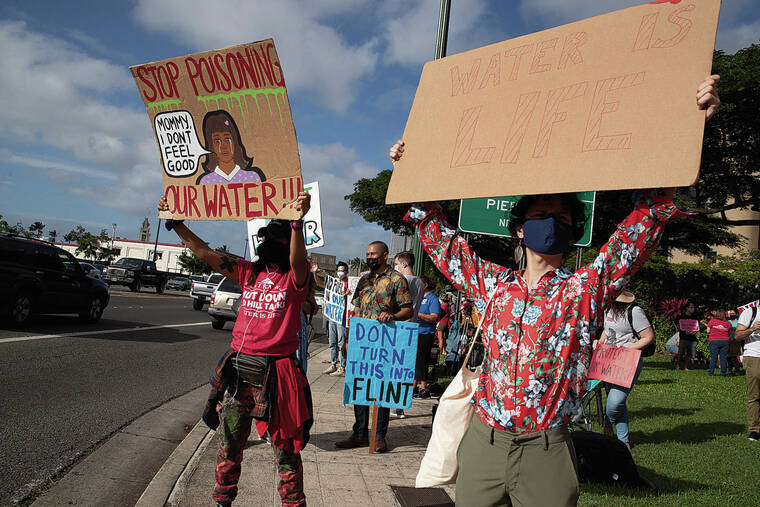With Oahu’s largest source of drinking water at risk of contamination from the Navy’s Red Hill Bulk Fuel Storage Facility, a growing coalition of environmental, Native Hawaiian and community leaders are calling for the facility to be shut down.
Some 80 people Friday afternoon rallied on the lawn near the Prince Kuhio Federal Building to call for the decommissioning of the 20 Red Hill fuel tanks, which sit 100 feet above an aquifer that provides drinking water for hundreds of thousands of Oahu residents.
Demonstrators waved to passing vehicles on Ala Moana Boulevard and held signs that read “Shut down Red Hill” and “No jet fuel into our water.”
Among those speaking at the rally were Gary Gill, who was state deputy health director for the environment during a 27,000-gallon fuel leak at Red Hill in 2014.
“I’m sorry to say it’s too late to fix it up. It is too late,” Gill said. “There is petroleum- stained bedrock under each one of these tanks. There has been petroleum byproduct constantly underneath these tanks. Now we see that that contamination is poisoning people who live here in Hawaii.”
>> RELATED: Hawaii officials say Red Hill, Aliamanu school water samples damaged in transit
>> RELATED: Board of Water Supply shuts down Halawa well
>> RELATED: Army task force helping Hawaii families affected by tainted water supply
>> RELATED: Former Govs. Waihee and Abercrombie call for closure of Red Hill fuel facility
Others signs read “Protect our water” and “Don’t turn this into Flint,” a reference to the years-long water contamination crisis in Flint, Mich., caused by a poorly treated and tested water supply.
“None of us create water, but we have a kuleana, a duty, to ensure that the lives that come after us — the babies and the keiki that we bring into our world — will have the fresh, clean and life-giving waters of our islands,” said Kamanamaikalani Beamer, a University of Hawaii at Manoa professor who was representing Aina Aloha Economic Futures, an initiative led by a group of Native Hawaiian leaders advocating for a Hawaii economy grounded in its “unique island culture and identity.”
Hundreds of military households have complained about the smell or taste of petroleum in their tap water, and the Navy has confirmed its presence in the water system. There is a growing concern the water supply for the island as a whole will be compromised.
“This public health crisis has been on the Navy’s watch, in the Navy’s own facilities, to the Navy’s own families. If the Navy cannot even be accountable to the families they employ and bring to Hawaii, what does that mean for the rest of us?” said Sam Ikehara, a community organizer who lives in Kalihi.
Moana Bjur, executive director of the Conservation Council for Hawaii, said the contaminated water would affect environmental resources and cultural practices important to Native Hawaiians because it could be detrimental to native plants.
The Honolulu Board of Water Supply on Friday shut down its Halawa well as a precautionary measure to protect the water supply for about 20% of urban Oahu. The BWS water system and the Navy’s are separate, but both take water from the same aquifer.
The coalition also demanded that federal leaders — including President Joe Biden and Navy Secretary Carlos Del Toro, who is scheduled to be in Hawaii on Tuesday for Pearl Harbor 80th-anniversary commemorations — meet directly with community leaders instead of just with the local Navy leadership, which has lost public trust for its handling of the water crisis.
“Stop listening to these local Navy commanders who are clearly incompetent and reckless in their constant disregard and dismissal of our concerns, to the point where we now have families being poisoned,” said Wayne Tanaka, director of the Sierra Club of Hawaii.
Families who have been directly affected by the water issue have called out Navy leadership for initially telling them the water was safe instead of taking precautionary measures to protect them.
Worries about the Red Hill fuel tanks are not new. Leaks have been a decades- long issue for the 80-year-old facility. Incidents this year alone include a 7,100-gallon fuel leak in January, a 1,600-gallon leak in May and a 14,000-gallon leak in late November.
“What’s happening right now is unthinkable, and at the same time it’s something we’ve seen coming for years,” Tanaka said.
The Sierra Club and BWS have opposed the Navy’s application for a five-year permit to maintain and operate the Red Hill fuel storage facility. After the 27,000-gallon fuel leak in 2014, the U.S. Environmental Protection Agency entered into an agreement requiring the Navy to study and monitor the tanks.
In July the state Department of Health said the Navy hadn’t shown it can operate the fuel tanks safely. DOH also this year fined the Navy for safety violations related to leaks at the tanks.

